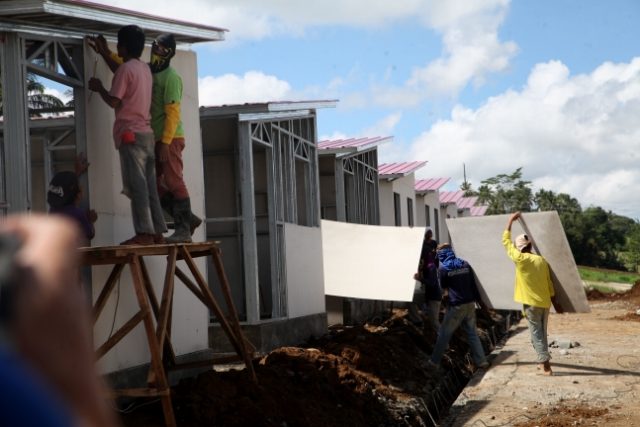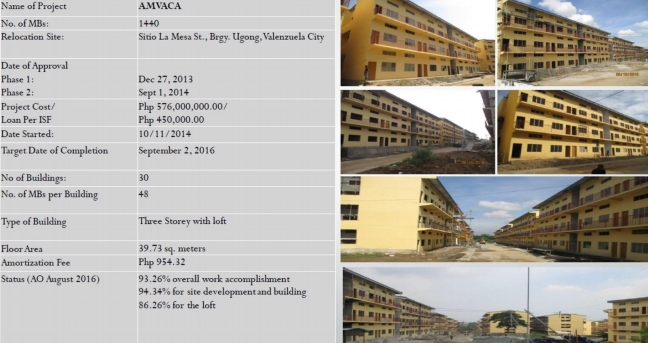
There are some 500,000 informal settler families in Metro Manila, many of whom are threatened by eviction and demolition. Many have been relocated outside the city, where jobs are few jobs and access to public services is limited at best.
While the situation may seem hopeless, there is a ray of hope in 14 “people’s plans” or socialized housing projects that have been developed and proposed by informal settlers’ housing cooperatives and associations.
According to Erik Villanueva, general manager of Kilos Maralita Federation of Housing and Community Service Cooperatives (KM Federation), this initiative began under the previous administration of president Benigno Aquino III, with all 14 projects having been approved and are now under various stages of construction.
Some 10,477 families from KM Federation-affiliated associations are benefiting from these P4.4-billion in-city and near-city housing projects.
Villanueva is appealing, however, to President Rodrigo Duterte to channel support funding for at least 22 more people’s plans for socialized housing projects, which will benefit 17,343 families from KM Federation-affiliated associations, 14 of which have complete costing packages (covering total land cost, site development cost, building cost, cost of facilities, and other costs) that add up to P5.3 billion.
Over 7,800 more families from 19 KM-affiliated associations are still completing their people’s plans.
“May mga concrete solution tayo (We have concrete solutions here),” Villanueva stressed early this month during a press briefing to promote the recently concluded Asia-Europe People’s Forum conference on assuring affordable, accessible, and quality public services for all.
Twelve of the initial 14 people’s plans are financed by the Social Housing Finance Corporation (SHFC). According to the latter’s website, it is the “lead government agency” that undertakes “social housing programs that will cater to the formal and informal sectors in the low-income bracket” and takes charge of “developing and administering social housing program schemes.”
With a P9 billion fund during the term of then president Benigno Aquino III, the SHFC’s High Density Housing Program enabled informal settler families living in danger zones in Metro Manila to acquire “safe and flood-resilient permanent housing solutions,” according to its website.
The 14 people’s plans that have made it to the construction phase are located in the following communities:
– Brgy. Muzon, San Jose Del Monte City, Bulacan (546 families with a cost of P245 million)
– Brgy. Muzon, San Jose Del Monte City, Bulacan (Another 546 families with a cost of P245 million)
– Brgy. 171, Caloocan City (390 families with a cost of P169 million)
– Brgy. Ugong, Valenzuela City (1,440 families with a cost of P648 million)
– Brgy. Malinta, Valenzuela City (864 families with a cost of P388 million)
– Camarin, Caloocan City (720 families with a cost of P324 million)
– Brgy. Kaypian, San Jose Del Monte City, Bulacan (1,406 families with a cost of P517 million)
– Brgy. Gaya-Gaya, San Jose Del Monte City, Bulacan (1,504 families with a cost of P661 million)
– Brgy. Pasong Tamo, Quezon City (1,039 families with a cost of P413 million)
– Brgy. San Isidro, Parañaque City (884 families with a cost of P397 million)
– L. Francisco St., Pasay City (109 families with a cost of P49 million)
– Brgy. Muzon, San Jose Del Monte City, Bulacan (800 families with a cost of P270 million)
– Brgy. Bignay, Valenzuela City (192 families with a cost of P86 million)
– Brgy. 171, Caloocan City (37 families with a cost of P3 million)

(Above) Details about one project under construction in Brgy. Ugong, Valenzuela City, benefiting 1,440 families. Courtesy of Erik Villanueva.
According to Villanueva, they expected that the 22 other people’s plans would be funded under the High Density Housing Program too.
“However, by the time these 22 groups were able to compete and fully prepare their project proposals, allocations from the P50 billion fund were already committed by SHFC to other housing projects and by NHA (National Housing Authority) to mostly off-city resettlement projects,” he said.
According to the SHFC website, the previous administration had a P50-billion budget for five years for the government’s housing program for informal settler families.
“Naubusan ng pondo, ika nga (As they say, the funds ran out)… Around two-thirds of the P50-billion fund went to NHA’s construction of resettlement sites, which is the relocation option least preferred by the informal settlers,” Villanueva said.
They are now “exploring” the option of having the 22 people’s plans financed by Pag-IBIG or the Home Development Mutual Fund.
Another possibility is “financing and implementation by developers who will later be re-financed by PAG-IBIG,” Villanueva said.
“Developers would be those needing to comply with the amended Balanced Housing Act, under which subdivision and condominium developers are required to develop socialized housing projects that are 15 percent and five percent, respectively, of their main subdivision or condo projects,” he explained.
The target relocation sites in the 22 people’s plans are Bacoor, Kawit, Tanza, Trece Martires, Cavite; Montalban, San Mateo, and Antipolo City, Rizal; San Jose Del Monte, Bulacan; Quezon City; Malabon City; Taguig City; Caloocan City; Valenzuela City; and Pasay City.



